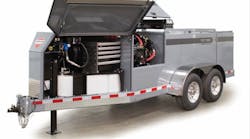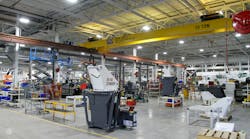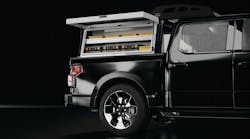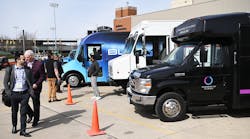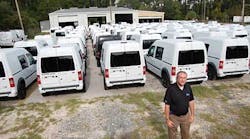For Dejana Truck & Utility Equipment, things are jammin' in Jacksonville.
Dejana — a family-owned, full-line truck equipment house with headquarters in Kings Park, NY, seven manufacturing facilities, and four truck-equipment showrooms — was so successful in the first two years of its Ford Transit Connect ship-through facility in Baltimore that Ford asked it to start one in Jacksonville in 2011 to service the Southeast market.
On a pristine fall morning, production manager Mike Canaan surveys the packed lot and reflects on what Dejana has accomplished since May 2009 with the ship-through program.
“We're expecting to see more volume with the Transit Connect ship-through this year than previous years,” he says.
Dejana also supplies upfitted Chevy, GMC, Dodge, and Isuzu trucks, along with utility equipment such as landscapers, hooklifts, and snow and ice removal equipment at its other locations, but the Transit Connect program has taken the company to a new level. In 2011, Dejana received the award for #1 Bailment Pool in the Country from Ford for the 10th year, and was on track to be #1 again with just two weeks left in 2012.
“It means our customers like our quality, they like our services, they like doing business with us year in and year out,” vice-president Andy Dejana says. “When we started in Baltimore, the Transit Connect was a baby. We were involved with the first Transit Connects that came across. It's been a very successful vehicle as far as commercial applications.
“It's been a good program for us, and the program continues to grow. The overall goal of the vehicles coming into Jacksonville was to get better service to dealerships and fleets in the southeast territory.”
The units are ideally suited for parcel delivery, service, and trade applications, and inner-city commercial use — they're highly maneuverable, thanks to a 39-foot curb-to-curb turning diameter.
The Transit comes with a 2.0L Duaratec Engine with 136 horsepower and 136 ft-lb of torque, can travel up to 354 miles on a single tank of gas, and has a 1600-pound payload capacity. The interior offers up to 129.6 cubic feet of cargo space and can accommodate items up to 6 feet long, 4 feet wide, and nearly 5 feet tall.
It is designed with a low load height (less than two feet) to make loading and unloading cargo as easy as possible. The rear cargo doors come with a standard 180° swing angle. If more working clearance is needed, there are doors on articulated hinges that swing up to 255°.
Dejana says he isn't surprised at the vehicle's growth in popularity in the US market.
“A lot of customers were trying to use a car as a vehicle they needed to carry equipment in, and this is a combination of the two. It's more like driving an Explorer than it is driving a van. So if companies are hiring somebody to drive a vehicle, they're not driving a truck. It's comfortable and not intimidating to put somebody who's not a highly skilled driver in the vehicle. That's the attractiveness of the vehicle, along with the fuel mileage.”
Learning from Baltimore
The Jacksonville location mirrors the Baltimore operation, having the ability to install interior packages from a variety of suppliers, as well as custom fleet work. Since the Transit Connect ship-through program began in May 2009, Dejana's Baltimore location installed interior packages in more than 70 units per day.
Here's how it works:
Dejana gets a release list, picks up the vehicles, and brings them to its Jacksonville facility, where each vehicle is bar-coded and staged for production.
The facility has two production lines, with each featuring 10 cells. The first two cells are for vehicles staged to go into production, the next two are for installing ladder racks and doing electrical work, the next two for partitions, the next two for cabinet packages, and the last two for quality control.
As the vehicles are completed, Dejana's bar-code system tracks their progress, and that information is reported to carriers, Ford, and leasing companies to alert them that the vehicles are ready to be picked up.
Dejana learned from its experience in Baltimore, where it devotes 30,000 square feet to the Transit Connect ship-through out of its total of 75,000. They have five assembly lines there for the Transit Connect: two for the standard package to get things quickly and the rest for complex upfits that would include a whole variety of interiors as well as any customization a fleet might need, from computer systems to ladder racks to camera systems.
“Everything we do in Jacksonville we learned in Baltimore,” Dejana says. “The Jacksonville and Baltimore facilities are running identically. We always make process improvements. We are constantly evaluating what we're doing and making improvements.”
“When a boat comes in, we know we're going to have a large volume of vehicles we have to accommodate, so we needed to have the space for all those vehicles. We can anticipate those demands in Jacksonville because of what we learned in Baltimore. Because we have good data flow and visibility, we can pre-build components and cabinetry so they're ready upon arrival, and we can just have them go through the appropriate production line, so everything is streamlined and efficient.”
Dejana says the frequent question, just as in truck equipment, is: How long does it take?
He says they have Transit Connect upfits that take two hours and others that take 30 hours, along with everything in between.
“The real challenge of it is balancing the materials coming in to when the vehicles are coming, and also balancing the product lines to be very efficient with all the complexity of the builds,” he says.
“We can't get choked on 10 30-hour installs and then all of a sudden have 100 standard products coming behind it, and just have a logjam,” Idtensohn says.
“That's where the flexibility of the different lines comes in,” Dejana adds. “We have the flexibility to run several production lines at once. We run high labor down one line and low labor down different lines. We start with one line with easy builds and will push the complexity out over different lines and also use different technicians for harder installations. There are some that are very custom, where we need better technicians to do upfits than we do on standard product. So we have to balance the labor, balance the hours per line, balance the throughput, and then get the goals on how fast we turn the vehicles.
“And then at the end of the process, some gets decals or even wraps. The complexity of decals as far as labor time also varies dramatically. Each customer has their own decal package, and those wraps could be very quick or it could take a full day to wrap one vehicle.”
Upfit options
Dejana, together with Commercial Van Interiors of Whittier, California, offers a variety of upfit options and interior accessory packages. A series of flexible, base-level upfit packages are available that can easily be combined with a variety of trade-specific upgrades to satisfy a broad range of requirements. In addition, customers and dealerships also have the option of completely customizing their van interiors using packages from suppliers such as Adrian Steel, Leggett & Platt, Sortimo, and Dejana.
Bulkheads safeguard the van cab area against moving and shifting cargo. The P2TCFW wire-mesh partition provides maximum visibility, and the recessed design allows for maximum adjustability of driver and passenger seats.
The P2TCS partition features all steel panels that help control climate and safeguard the van cab area against moving or shifting cargo. The perforated window provides full visibility of the cargo area and rear windows. Steel header and full perimeter wings provide optimal security and prevent access to the cargo doors from the cab area or vice versa.
Adrian Steel provides flexible and dependable storage solutions for the Transit Connect. Interior packages combine rugged durability with lighter weight construction for optimal cargo capacity. The position of the shelving allows for easy access to cargo from both the side and rear doors. Packages include wall liner, cargo management, base, intermediate, or premium shelving.
The poly liner package is designed to protect the walls of the van. The liner is molded to conform to the shape of the van walls, and runs from floor to the headliner. The kit comes with full length E-track and straps for securing large cargo. The liner is designed to work with the OEM floor mat and a plywood floor.
The cargo management package is an economical choice to provide the maximum cargo-carrying capacity. Cargo can be easily managed with an E-Track system installed on both sides of the van walls to safely tie down and secure goods. It includes two heavy-duty adjustable nylon E-Track straps to secure cargo in place.
The storage and tie-down package features one AD32FP shelving unit (32×46×14) with three truly adjustable shelves. Shelves can be adjusted to meet specific cargo needs in less than a minute. The precision stamped end panels and shelves provide lightweight, rugged and dependable storage. The base shelving package provides 9.33 square feet of shelf space. A new installation kit has been designed to minimize drilling into the vehicle. This floor plate kit secures the shelving unit to the floor utilizing pre-existing holes in the vehicle, with only one hole needed to be drilled in the header. On the other side of the van, one floor rail and one belt line rail is provided on the opposite side to secure cargo with two adjustable tie-down hooks.
The all new AD Series shelving features stamped end panels and shelves that combine rugged durability with lighter weight construction for optimal cargo capacity. End panels are contoured to create maximum aisle space and feature a six-inch “knockout” at the floor for additional storage of wider items. The shelving is highly flexible and features three truly adjustable shelving so shelves can easily be raised, lowered, or added to accommodate any changes in the tools, equipment or cargo carried. Using only a screwdriver, the front shelf bolts can be removed so the shelf can be moved in one-inch increments to where it is needed. The standard AD Series shelf is 46×14×32.
The premium shelving package features two AD32FP steel shelving units (32×46×14) with three truly adjustable shelves. The package includes one #919 combination three-drawer unit and one DC12 three-drawer unit, and one TA1 four-hook bar-mounted on the curbside rear panel that is perfect for extension cords and hoses. A new installation kit has been designed to minimize drilling into the vehicle. This floor plate kit secures the shelving unit to the floor utilizing pre-existing holes in the vehicle with only one hole needed to be drilled in the header.
Dejana also has designed the Katerack system, which brings the tools out to the worker for faster, easier access to tools and inventory; eliminates the need to go inside the van; and saves time and maximizes productivity, which allows more service calls per day.
Multiple shelving packages can be used, and each shelf measures 42.5×36. Side Katerack shelves are also available and are 21" wide × 36" or 47" deep, leaving the rear space open for larger items.
“This is drawer system like a toolbox, so it's a pull-out shelf unit,” Dejana says. “It uses the height of the shelving package so you get to use the real cubic feet of the vehicle. You're not just using the sides.
“It's called Katerack because it caters to all different kinds of customer needs. Customers were trying to take their vehicles down from a bigger van or pickup truck with a cab to a smaller vehicle with better gas mileage. How were they going to get all that stuff into a more compact area, and how would they get to it? This is how. It's been a huge success with utilities, cable companies, and service techs. It's a really nice product.”
Bracing for more business
When Dejana first started the Transit Connect ship-through in Jacksonville, it was sub-contracting a 3000-square-foot facility at the Blount Island Marine Terminal. Dejana quickly outgrew that facility and started looking for something else.
“This facility is working well. This facility is ideal for a production line. It's an ideal facility for what we're using it for — production-line manufacturing. It's very efficient. We're getting the throughput that we need. It's working well.”
In the coming months, they will tear down one fence on the back lot and expand to add enough space for an additional 200-300 vehicles.
Dejana doesn't anticipate ever leaving this facility.
“I think this facility in Jacksonville is ideal for what we're looking at,” Dejana says. “If we need to expand capacity, we'd do second shifts.”
Which would actually be music to his ears.
